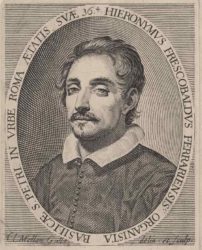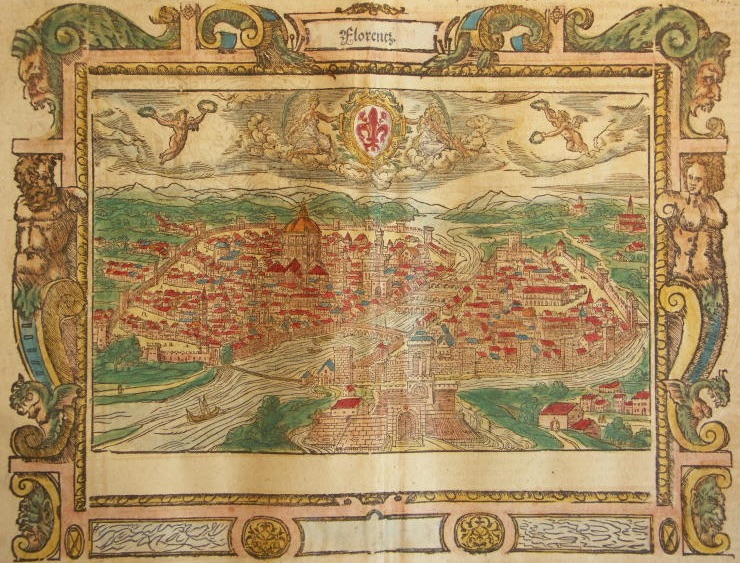Therefore there is happiness in Europe, yes, in Italy, yes; but more in beautiful Tuscany: and if in any City, not elsewhere than in most beautiful Florence: ruling City; rich City; City full of virtù; quiet City, with healthy air; in sum happy City.
È dunque la felicità nell’Europa sì, nell’Italia sì; ma più nella bella Toscana: e se in Città alcuna, non altrove, che nella bellissima Fiorenza: Città dominante; Città ricca; Città piena di virtù; Città quieta, d’aria salubre; Città insomma felice.
C. Bracci, Della cappella de’ Ser[enissi]mi Granduchi di Toscana … Arezzo, 1633.
9.1 By 1628, according to Libanori, “Frescobaldi, tired of remaining in Rome, called by the Grand Duke Ferdinando II he retired to Florence, and for many years served the Court, & had the Organ of Santa Croce, and aroused there the customary amazement, generally loved by all, and also envied by a few.”[1]
9.2 Despite the usual inaccuracy of some of Libanori’s details, his general picture is credible. In 1628 Frescobaldi was forty-five years old and had been organist of the Cappella Giulia, with its busy daily schedule and meager remuneration, for twenty years. He had published much of his important work and was acknowledged as the leading Italian virtuoso and composer of keyboard music. Adriano Banchieri included Frescobaldi among the addressees of his Lettere armoniche (1628), along with Artusi, Diruta, Guami, and Monteverdi, praising Frescobaldi’s “sweet keyboard playing” (“tasteggiamento soave”).[2] About the same time Marchese Vincenzo Giustiniani (the friend of Bernardo Bizzoni, patron of Caravaggio, and one of the most perceptive collectors and patrons of the arts in seventeenth-century Rome) declared, “For Organ and Harpsichord Geronimo Frescobaldi of Ferrara surpasses all, both in skill and in the agility of his hands.”[3]
9.3 Frescobaldi’s Roman income from its various sources seems to have been sufficient to support a large family living a relatively settled life. The abilities and literary talent of his son Domenico were to lead to the security of a benefice at St. Peter’s. Girolamo’s commitment to this Roman career was not, however, proof against offers of financial advantage and artistic recognition. But after the failure of the Mantuan project such offers had to be more definite and more attractive. By 1628 comparatively few northern Italian courts—principally Florence and Venice—could provide the necessary financial and artistic cachet.
9.4 There appears to be no record of Girolamo’s preliminary negotiations with the Florentine court. Ferdinando II de’ Medici (1610-70) succeeded as Grand Duke of Tuscany on the death of his father Cosimo II (1590-1621). He was to attain his majority on his eighteenth birthday, 14 July 1628, releasing him from the joint regency of his mother and grandmother, the archduchess Maria Maddalena of Austria and the Grand Duchess Christina of Lorraine. On 1 March (Mercoledì Grasso) of 1628 Ferdinando arrived in Rome incognito with his younger brother, the future cardinal Gian Carlo (1611-63), to reverence Urban VIII and to see the city, as part of a journey across Italy and Austria.
Figure 9.1a / 9.1b
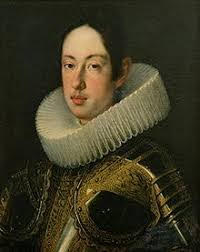

Frescobaldi’s friend the erudite Lelio Guidiccioni, who had just furnished ghostwriting the Latin dedication of the Liber secundus diversarum modulationum, was sent to welcome the two princes to Villa Borghese and to expound to them the villa’s art-works. (According to the Pinacotheca of Erythraeus [G. V. Rossi], Guidiccioni “became senseless, speechless, nor was he able to utter a word.”)[4]
9.5 During Ferdinando’s two-week stay in Rome, impeded by the rainy season,[5] he may have encountered Frescobaldi at St. Peter’s, at a papal banquet, or at one of the splendid entertainments given in his honor by the Aldobrandini. On March 8 the princes attended the papal cappella for Ash Wednesday. On March 14 Pope Urban offered them a dinner at which Loreto Vittori sang “Latin odes composed by the Pope himself.”[6] Ottavio Tronsarelli’s Belvedere, dedicated to Ferdinando, was presented for the Medici by Cardinal Ippolito Aldobrandini at the Villa Belvedere in Frascati: “The scene is the Villa Aldobrandini.” The Argomento:
Ferdinand II, Grand Duke of Tuscany, is received in the Villa Aldobrandini near Frascati by the Most Eminent Cardinal Ippolito with royal pomp; whence Belvedere the God of that wood, Algio Deity of the Waters, and the Dryads, Nymphs of the trees, strive among themselves, in telling the praises of so worthy a Prince.[7]
9.6 The banquet “with entertainments of instrumental and vocal music” (“con trattenimenti di suoni e canti”) offered to the princes at the Villa Belvedere on 11 March was precisely the kind of occasion for which Frescobaldi was employed to engage singers and to perform with them. An unconfirmed statement (Franchi 2006, 1628/6) says that the Grand Duke even heard Girolamo perform on the famous water organ of the Stanza del Parnaso:
The chamber of the winds in the theater of Belvedere in Frascati with the famous fountain of Mount Parnassus with Apollo and the muses who play with hydraulic instruments powered by water, architecture by Giacomo della Porta.
9.7 After the banquet the Grand Duke was taken to visit “all those delightful, and artful fountains with their water-plays.”[8]
9.8 In his account of Frescobaldi’s departure from Rome, Libanori was correct on one point: Girolamo was indeed “called by the Grand Duke Ferdinando II.” From a dispatch by Tiburtio Masdoni, Modenese ambassador in Florence, to the Duke of Modena on 22 Oct 1628, we learn that the decision to hire Frescobaldi was the Grand Duke’s own initiative on assuming power as part of his coming of age:
The Most Serene Grand Duke has begun to exercise his Rule, and in addition to having revoked the right of arms he is forming a Company of excellent Musicians to make a cappella without having to employ any longer those [musicians] of the Duomo, and besides having secured the famous Frescobaldi with a large salary, he has also taken others into his service.[9]
9.9 The dedication of the part-book edition of the 1628 instrumental Canzoni to Ferdinando II was presumably part of the hiring process. (Franchi 2006, 1628/7 suggests that Frescobaldi ordered the 1628 edition of Toccate I, with a completely new title page different from both stages of 1616 and without references to the Gonzaga, in connection with the Grand Duke’s visit that year.) It seems curious that the Grand Duke should take the initiative in hiring Frescobaldi since he had the reputation of considering music “a mere step away from buffoonery” (Bonini 1979, xviii, n. 51). There is little evidence of the young Grand Duke’s character, but he had viewed some of the expensive spectacular entertainments of his Regents with a jaundiced eye (Harness 2006, 99).
9.10 The Chapter of St. Peter’s, meeting on 22 November 1628, gave permission “to D. Hier. Frescobaldi our organist to leave the City at the pleasure of the Chapter”; six days later Girolamo drew his salary for the rest of the year and departed, not to return to the basilica for almost six years.[10] His place was taken first on 1 December by Giacomo Guidi, organist at Santa Maria in Trastevere in 1624,[11] and at Guidi’s death in August 1630 (Kirkendale 1993, 378, n. 57: 15 June 1630 according to Jeanneret) by Giovanni Giacomo Porro (ca. 1590-1656), maestro di cappella of S. Lorenzo in Damaso in 1626 and 1629, who had taken part in the 1626 translation of the body of S. Giovanni Crisostomo and in the 1628 twelve-choir celebration at St. Peter’s (CG Censuali 79).[12] With Frescobaldi’s return imminent, Porro left for Vienna on 1 December 1633.[13]
9.11 A curious by-product of Frescobaldi’s Florentine venture has recently come to light, a fascicle of “Sonnets of various most excellent authors in praise of Sig. Girolamo Frescobaldi, Organist of the Most Serene Grand Duke of Tuscany” (“Sonetti di diversi eccellentiss[imi] autori in lode del Sig. Girolamo Frescobaldi, Organista del Sereniss[imo] Gran Duca Di Toscana”), edited by the composer, singer, and theorist Pietro Paolo Sabatini and printed in Rome by Andrea Fei, who had published Frescobaldi’s 1627 second book of motets. Sabbatini dedicated the collection to Francesco Nicolini, Ambassador of the Grand Duke (and the husband of a partisan of Galileo), who may have acted as an intermediary for Frescobaldi’s appointment like Paolo Facconi in 1615. In his dedication, dated 28 November 1628, Sabatini professed himself a former student of Frescobaldi (“già mio Maestro”). The collection contains five encomiastic sonnets, the last with lacunae filled in by hand in ink (fig. 9.2 Sonnets).[14]
Figure 9.2
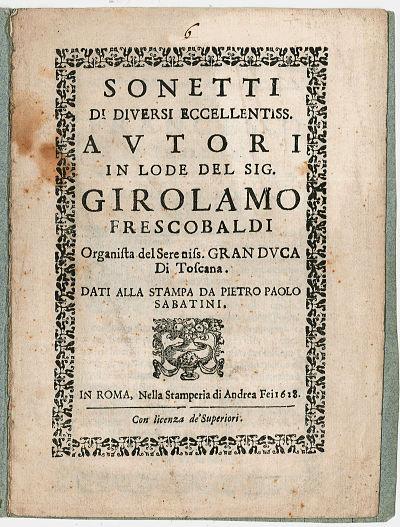
9.12 The seventeenth-century Florence to which Frescobaldi came has been portrayed as an almost entirely negative contrast to the Renaissance city familiar to and beloved of the tourist. The reign of Cosimo II and the regency of his wife and mother for his son Ferdinando II provided a welcome period of peace in the midst of the Italian conflicts of the Thirty Years’ War (1618-48) and the War of the Mantuan Succession (1628-31). Those years saw the transformation of the banking and mercantile Florence of the Renaissance into the model capital of a Baroque state. Taking as his point of reference the Cappella dei Principi, the mausoleum of the Medici grand dukes begun in 1604, the art historian Michael Levey asked, “Is it worth trying to understand both what we see and the ambitions, dynastic and artistic, fated never to be fully realised, which lie behind it?” An affirmative answer leads to seeking a “‘second’ Florence, a city more shadowy and elusive … than the famous, familiar medieval-Renaissance one.” Levey symbolizes this second Florence by the art of pietre dure, the intarsia-work of semi-precious stones that comprises the basic decoration of the Cappella dei Principi, in the colors of “dried seaweed and dried blood” (fig. 9.3 Cappella dei principi).[15]
Figure 9.3
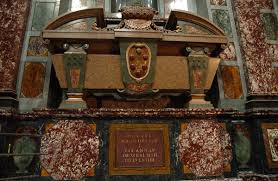
9.13 The vigorous artistic life in Florentine sculpture at this period was exemplified in the work of Pietro Tacca (1577-1640). New currents in painting emerged in the work of Galileo’s friend Ludovico Cigoli (1559-1613) and in Matteo Rosselli’s decorations for the Casino Mediceo, the town residence of Ferdinando II’s uncle Cardinal Carlo de’ Medici (1595-1666). In 1641 the grand duke, an impassioned follower of the new astronomical science, was able to entice Pietro da Cortona from Rome and from the service of the Barberini to complete the Planetary Rooms in Palazzo Pitti, begun in 1637—perhaps the greatest single decorative complex in seventeenth-century Italian art (see Campbell 1977).
9.14 In literature, the Florentine Accademia della Crusca had published its pathbreaking Vocabolario of the Italian language in Venice in 1612. The Florentines applauded the “foreign” poets G. B. Marino and Gabriello Chiabrera (1552-1638), as well as their Tuscan compatriots the able playwright Michelangelo Buonarotti, jr. (1568-1647: see Cole 2011) and the dramatist-librettists Andrea Salvadori (1591-1634) and Ferdinando di Curzio Saracinelli, Balì of Volterra (1587-1640). Saracinelli, who supervised the court entertainments, may have been the author of Il corago, an important treatise on stagecraft: seven unattributed texts quoted there are taken from his libretto for Francesca Caccini’s comedy-ballet La liberazione di Ruggiero dall’isola di Alcina, presented at Poggio Imperiale in 1625.
9.15 The court of the Regents has often been presented as a gynocracy devoted mainly to pious exercises. This view has been challenged especially by Kelley Harness (2006) and by Suzanne C. Cusick in her study of Francesca Caccini (2009). In fact, the Regents, and especially the archduchess Maria Maddalena, presided over a court marked by chivalric combats and theatrical and musical entertainments which notably celebrated mulieres fortes of sacred history and legend such as Judith and St. Ursula. Maria Maddalena took an active role in the preparation of at least six of the twenty entertainments presented at court during her regency, which included four fully sung operas. Salvadori, librettist of La regina Sant’Orsola (1624) and La Flora (1628), wrote of her, “For her melody returned to its primal glory: for her the Theater saw its greatness” (“Per lei tornò la melodia alla sua prima gloria: per lei vide il Teatro la sua grandezza”: Harness 2000, 41).
9.16 The daily life of the Tuscan court is recorded in detail in letters, diaries, and administrative and financial records. Like many seventeenth-century courts, it was peripatetic: although Florence remained the administrative capital of the Medici, they regularly traveled to Livorno, Pistoia, and Siena. They visited Pisa, the seat of the ducal military order of Santo Stefano, especially for Holy Week at the church of S. Nicola. The court hunted in Impruneta and enjoyed the countryside at the numerous Medici villas, especially Maria Maddalena’s dower villa Poggio Imperiale. The life of the court followed the Church year, plus a few specifically Florentine celebrations such as the Carnival festivity of the city’s patron, St. John Baptist, on 24 June. This annual cycle was varied by state visits, royal births, marriages, deaths, and natural disasters.[16]
9.17 The musical establishment that Frescobaldi joined had been formed by Ferdinando I (1549-1609) and assumed particular prominence during the last years of Cosimo II, when the ailing Grand Duke heard music in his chambers nearly every day and rewarded the performers with lavish gifts.[17]
9.18 In a ruolo of Ferdinando I the members of the Florentine court were ranked in some forty-four categories of which the musicians headed the lowest section.[18] The Florentine court musica, by 1624 under the general supervision of the Balì Saracinelli (Carter 2013, 240-43), was divided into four groups according to Carlo Strozzi’s report of 1646:
[in] singers and players for the chapel and for the chamber and for the stage or other needs; in women similarly kept for the same purposes; in violin-players for dances and parties [festini] or for the table, who are called the ensemble of the francesi; and in players of wind instruments, called the ensemble of the franciosini, who also play at table on occasion of feste and foreign guests and the like, and publicly for the city in the ringhiera three times a week in summer.[19]
9.19 (The ringhiera was the iron-fenced terrace in front of the Palazzo Vecchio: see fig. 9.4 ringhiera.)
Figure 9.4
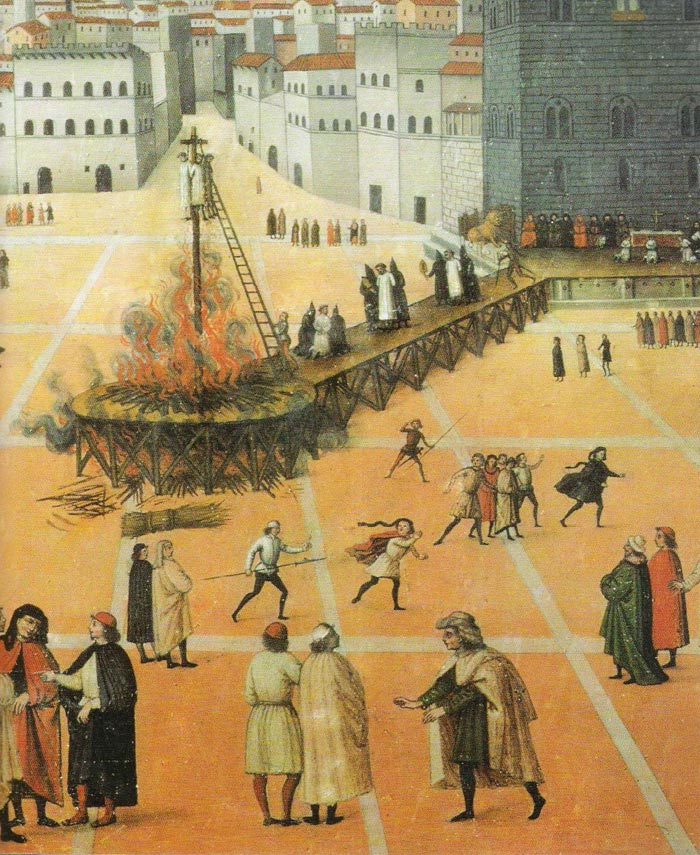
9.20 The chapel-music contained three male sopranos, one male alto, three tenors, and one bass, plus five women, two lutes, two theorboes, keyboard, and a harp. The concerto di ballo comprised five string players; the franciosini numbered eight performers on loud (haut) wind instruments such as cornetts, shawm, and sackbuts.
9.21 The court archives for 1626 record a total expenditure of 3,180 florins (equalling about the same sum in Roman scudi) for eleven singers, eight winds, five string players, three keyboard and lute players, and three others (Carter 2013, 231-34). One musico was in charge of the guardaroba della musica, which loaned instruments to the court musicians.
9.22 Marco da Gagliano (1582-1643), the leading Florentine composer, served as maestro di cappella to the Grand Duke and at the Duomo and the Baptistery under the guilds of the Lana (wool) and the Calimala (cloth) respectively, and was a canon of the Medici church of San Lorenzo. His colleagues in the musica included his brother Giovanni Battista (1594-1651), a theorbist, the virtuoso singer Vittoria Archilei (fl. 1582: last reported active in 1620 but still being paid in the 1631), and the lutenist and composer Lorenzo Allegri (c. 1573-1648). (Settimia Caccini’s husband Alessandro Ghivizzani had been banned from the court in 1611. The two went to Mantua, where they were dismissed by Ferdinando Gonzaga in 1619. After Ghivizzani’s death in 1630, Frescobaldi’s once-proposed bride returned to the Florentine court in 1632 until her own death ca. 1638.) Perhaps the most prominent member of the musica was Settimia’s sister Francesca (1587-after 1641), celebrated as poet, performer and composer. Unfortunately, Frescobaldi would probably not have encountered her since in October of 1627 she had married a Lucchese nobleman and moved to Lucca, where she was trapped by the quarantine for the plague until it was lifted on 1 January 1634.
9.23 In 1630 the celebrated trumpeter Girolamo Fantini, “the most excellent trumpet-player of all Italy” (“tubicene totius Italiæ excellentissimus”), joined Ferdinando’s household (1631: “nuovo trombetto di S. A. S,” at a salary of sc. 10 per month: Kirkendale 1993, 43, n. 34; fig. 9.5 Fantini). His name is linked with Frescobaldi’s by Marin Mersenne, whose informant was Pierre Bourdelot (1610-85), physician to Christina of Sweden and Louis XIII:
[the most learned Doctor Bourdelorius] in letters sent to me from Rome swears that he has heard Girolamo Fantini, the most excellent trumpet player in all Italy, say that he is able to play all the notes on his trumpet, and that he has played them with the organ of Cardinal Borghese, on which Girolamo Frescobaldi, organist of the Duke of Tuscany and of the church of St. Peter’s in Rome, played harmoniously.[20]
Figure 9.5
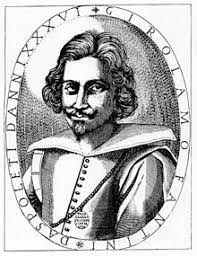
9.24 A letter of the young Medici prince Giovan Carlo (1611-63, fig. 9.1b) records the sensation caused by the playing of the “new Trombetta”:
“… who plays so divinely and musically, that as much as Frescobaldi is valiant on the harpsichord, so he [Fantini] prevails equally with the trumpet, indeed they have played concerts together, first in my chamber and then Sunday in the [great] hall while the Grand Duke dined, certainly with the amazement of the hearers”
9.25 30.11: 1630? [“trombetta nuovo”] “… che suona si divina e musicalmente, che quanto vale il Frescobaldi su l’instrumento, altrettanto prevale costui con la tromba, anzi hanno fatto concerti insieme, prima in camera mia e poi domenica in sale mentre desinaua il Granduca con meraviglia, certo di che senti” (Mamone 2003).
9.26 The Medici hired additional musicians from other courts to supplement their resident musica on important occasions. For the production of the Salvadori-Marco da Gagliano La Flora, an allegory of the passage of Florence from female to male rule presented for the celebrations of Ferdinando’s wedding with Vittoria della Rovere in October-December of 1628, the court borrowed Loreto Vittori from the Cappella Pontificia and from his patron Cardinal Ludovico Ludovisi. Although Vittori was summoned back to the papal chapel, he returned with four other singers and probably the lutenist Andrea Falconieri for the performance on 14 October 1628 (Harness 1998, 455). Traveling musicians regularly visited the court. In May of 1630 two of the most celebrated singers of the age, Adriana Basile and her daughter Leonora Baroni, performed twice for the regents at Villa Imperiale.[21]
9.27 A census of Florence taken in 1632 shows that the Frescobaldi family lived in the S. Maria Novella quarter, “dalla Croce al Trebbio” (= Trivio), where Giulio Caccini had owned a house, perhaps the same one (fig. 9.6 Santa Maria Novella). The Croce was a cruciform column encountered coming out of Piazza S. Maria Novella by Via Belledonne and leading to the trivium crossing of the Via Belledonne, Via Moro (between the trivium and Via delle Spade), and Via Trebbio. The Frescobaldi lived on a length of street between the Croce and Via degl’Asini (now Via del Moro); as the penultimate family of that section, they probably lived nearest Via degl’Asini. In 1596 Jacopo Peri had bought a house in the nearby Via dei Fossi (Carter 2013, 46). The neighborhood has been described as a quarter of artisans around a few homes of great wealth (Cusick 2009, 80).
Figure 9.6
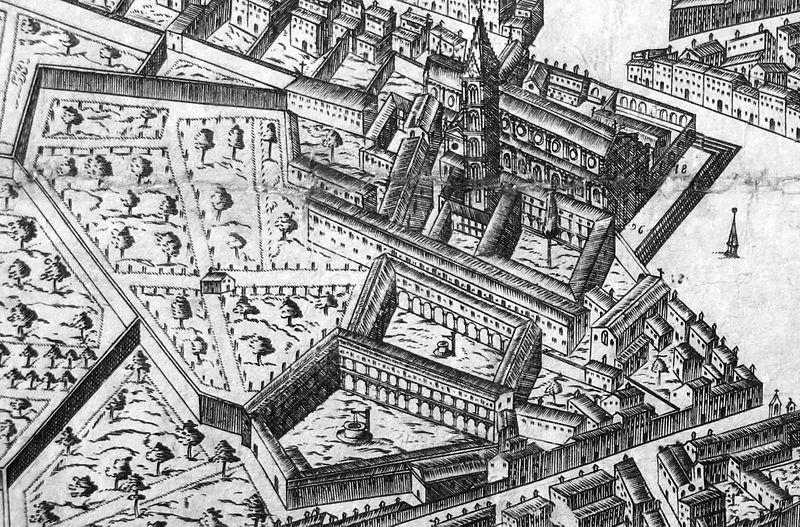
9.28 According to the 1632 census, Frescobaldi’s household consisted of two males (presumably Domenico, eighteen, and Stefano, fifteen), and one female under the age of fifteen (Caterina, thirteen); two females over fifteen (presumably Orsola and perhaps Maddalena, who would have been nineteen), and a servant.[22]
9.29 We have some information on the dwellings of Florentine court musicians. Francesca Caccini owned houses valued at sc. 540 and sc. 900 (Cusick 2009, 81). These probably resembled the house of their neighbor Orazio Mochi, valued at sc. 600. The ground floor of Mochi’s house contained two chambers, a courtyard opening into a garden, and a cantina. The first floor consisted of a hall, camera, antecamera, and kitchen; the second floor contained a hall, camera, antecamera, and terrace. The house of another court musician, Domenico Belli (d. 1627) and his wife the court singer Angelica Sciamerone, near Ponte Vecchio, contained fourteen rooms on two floors. The ground floor was largely used for storage: it contained a cantina, a terrace, a room with wine, grain, and wood, a kitchen, and a pantry where music, musical instruments, and clothes were stored. The living quarters on the first floor consisted of a hall with a long table, chairs and stools; a bedchamber; a salottino with storage chests; and an antecamera with an armadio (Cusick, 2009, 81-82). Jacopo Peri’s house in Via dei Fossi comprised three stories with a court and garden and more than twelve rooms, including an oratorio (cf. fig. 9.7a-b Florentine houses).
Figure 9.7 a
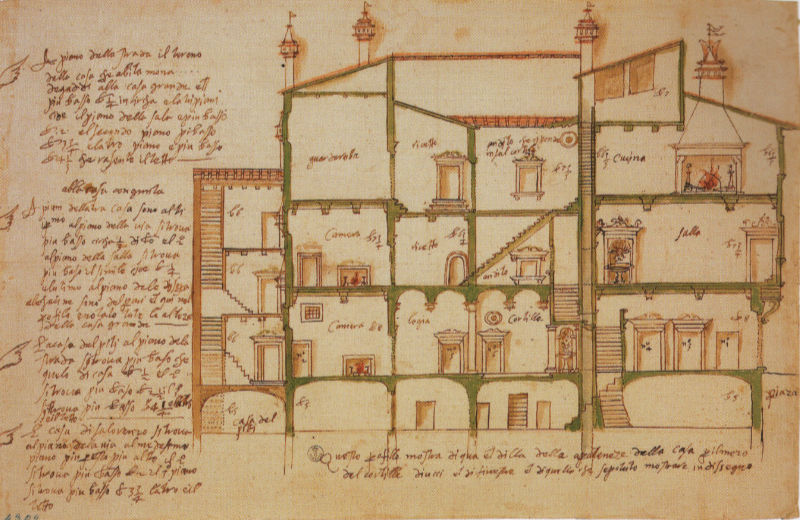
Figure 9.7 b
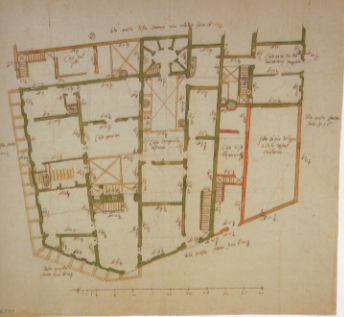
9.30 Frescobaldi’s position in the Florentine musica was variously defined. He is described as “Organista del Serenissimo Granduca di Toscana” on the title-pages of the sonetti and of his Arie musicali, published in Florence in 1630. A summary of account-rolls lists him simply as “musico” at a salary of sc. 25 a month (more than four times his salary at the Cappella Giulia), while in 1633 he was promoted to “maestro di cappella” with an increased stipend of 29 1/2 scudi monthly.[23] At sc. 300 to sc. 364 per annum Frescobaldi was the highest paid musician on the salary rolls, where the normal figure was 120 scudi a year, confirming the “grossa provisione” of the Modenese ambassador’s letter.[24] Although far below a dignitary like one of the Secretaries of State such as the Balì Andrea Cioli, in salary Frescobaldi ranked with the court sculptor Pietro Tacca, an artist of international reputation.[25]
9.31 On the evidence available, Girolamo was expected to perform with the court musica as keyboardist, to play the organ at special religious ceremonies participated in by the court, and probably to compose vocal chamber music. Presumably, in Florence as in Rome and Mantua, he did not take part in operatic productions or sacre rappresentazioni. On one occasion Frescobaldi directed and perhaps composed music for an extraordinary religious celebration promoted by a Florentine noble family. He served as organist of the Baptistery for at least a year and instructed a number of pupils. (Libanori also names him as organist of Santa Croce and San Lorenzo, but this is not substantiated by the surviving records of those churches.)[26] He may not even have spent the entire period in Florence. He visited Venice in 1630 (perhaps to see his publisher Vincenti), since he was entrusted there with a mosaic portrait to deliver to the Grand Duke.[27]
9.32 The evidence for these varied activities is best considered in the larger context of Florentine music during Frescobaldi’s stay. On 22 April of 1629, Dominica in albis, the octave of Easter, Urban VIII initiated months of festivities in Rome and Florence by canonizing the Florentine Carmelite Andrea Corsini (1302-74), Bishop of Fiesole, a ceremony to which Maria de’ Medici contributed and in which the French ambassador to the Holy See, Philippe de Béthune (1561-1649, the brother of Maurice de Sully), played a prominent ceremonial role. St. Peter’s was decorated with an apparato of “most beautiful Architecture, and with a great number of colored stone columns, and a large cornice above.”[28] A week later the new saint’s banner was carried in procession from St. Peter’s to Santa Maria in Traspontina.
9.33 The Corsini, among the wealthiest of Florentine noble families, provided lavish celebrations in Rome and underwrote similar spectacles for Florence: processions, fireworks, and an elaborate temporary façade for Santa Maria del Carmine, where the new saint’s body was displayed and his chapel eventually erected (fig. 9.8 Canonisation). The inaugural procession on 1 July 1629 began at the Duomo and wound its way with the saint’s banner across the river to the Carmine:
There followed an ensemble of trumpets, and to this there succeeded the whole cappella of the Duomo, and of the Grand Duke, with more than sixty singers. Whose most skilled and best known leader, and guide is Sig. Marco da Gagliano, canon of the illustrious collegiate church of San Lorenzo. After the singers came another ensemble of trumpets, which vied with the first one in rejoicing the populace with repeated sounds, so that the entire way one heard, either the song of musical voices, or the sound of festive trumpets.
[In the church] Facing the organ there was a large and elevated platform for the use of the musica, which was most beautiful, morning and daytime for the entire octave, since it had been entrusted to Signor Girolamo Frescobaldi, most celebrated musician of the Most Serene Grand Duke.[29]
Figure 9.8
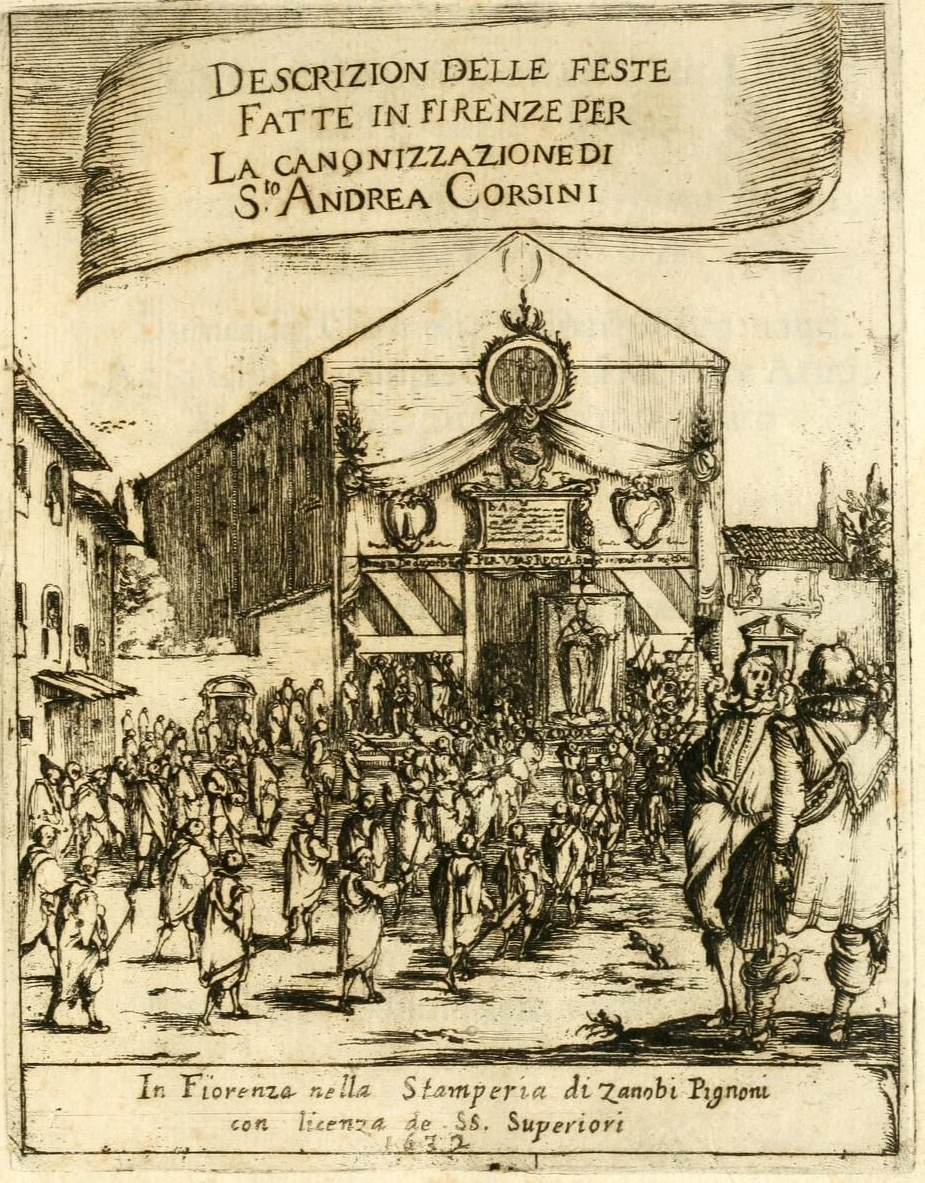
9.34 The string and wind bands enumerated by Carlo Strozzi in 1646 provided music for court dancing and banquets, and the chamber musicians performed in private for more select audiences. An intimate picture of post-prandial diversions at the Tuscan court is given in Cassiano dal Pozzo’s diary of Cardinal Francesco Barberini’s return from his nunciature to Spain in 1626:
After dining, they retired to one of the adjoining rooms, and the said Lord Cardinals palyed rovescino [a variant of the popular card game of tressette] with the Most Serene Grand Duke, while Cecchina [Francesca Caccini] sang various arias to the harpsichord and then to the harp, both played by her.
9.35 “After two hours of this entertainment” the Grand Duke, cardinals, and princes left the archduchess and Grand Duchess and went to course hares.[30]
9.36 Such occasions were frequent, but Girolamo’s participation is mentioned only once in the court diaries of Cesare Tinghi, during a visit of M. de Béthune (fig. 9.9) in 1630. On 29 May “while they dined music was played by the franciosini [the wind band], after dinner they all returned to the chamber of the Most Serene Archduchess and stayed to hear Domenichino castrato and Father Onorato [Magi] sing and they heard Frescobaldi play.”
9.37 (Girolamo’s two books of Arie, published the same year as this entertainment, perhaps reflect his association with such court performances.) [31] On similar occasions Frescobaldi is not mentioned.
Figure 9.9
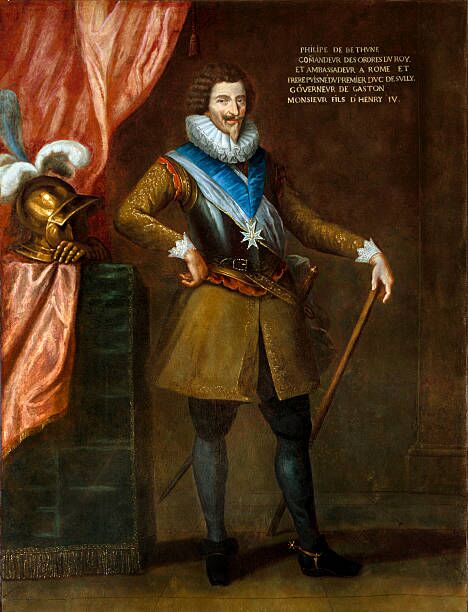
9.38 Of Frescobaldi’s colleagues in the performance on 29 May 1630, Domenico (Domenichino) Sarti was a castrato soprano whose name first appears on a court ruolo in 1619 (18 August 1628 at sc. 12, 3 March 1632-48 at sc. 15). From 1628-52 he received twice yearly disbursements of sc. 27 from the Medici guardaroba. On 1 March 1629 [1628 in Tinghi 19052, 188] he sang the role of Idumena Maga in Cicognini’s Trionfo di David, with music by the lutenist Agnolo Conti, for the Compagnia dell’arcangelo Raffaello. On Easter (31 March) 1630 he sang there again: “and there was truly angelic music by one voice, which was the celebrated Domenico Sarti one of our brethren” (“et vi fu musica veramente angelica di una voce, che fu il celebratissimo Domenico Sarti uno de’ nostri fratelli”). On 1 July 1630 he performed with five other Florentine musicians, including Frescobaldi, at the inauguration of the new cathedral in Colle Val d’Elsa (see below). On 21 July 1630 Sarti sang for the Queen of Hungary with Onorato Magi. At the Annunziata on 10 Nov. 1635 he performed “in choir, and in the organ loft on all the feasts gratis with his very sonorous voice” (“in choro, e su l’organo tutte le feste gratis con la sua voce tanto sonora”: Kirkendale 1993, 367). Sarti seems to have been a favorite of the archduchess, who made sure that he was given a good part in the casting of La Flora.
9.39 The tenor Onorato Magi was a Vallombrosan monk of Santa Trinità. He appears on the court ruolo of 1628 at a salary of sc. 10. Magi was probably a pupil of Francesco Rasi’s brother Gregorio, who “made in the [Vallombrosan] congregation many eminent pupils, among whom … D. Orazio [!] Maggi who was a singer [musico] at the court chapel” (“fece nella congregazione molti allievi insigni, tra i quali … D. Orazio Maggi che fu musico alla cappella di corte”: Kirkendale 1993, 376-77).
9.40 Some recently-discovered letters of the eighteen-year-old Medici prince Giovan Carlo (1611-63, fig. 9.1b) show us Frescobaldi involved in a less formal kind of music making along with the Grand Duke’s other younger brothers Matthias (1613-67), Francesco (1614-34, fig. 9.10a, who was to die of the plague in July 1634 at the siege of Ratisbon), and Leopoldo (1617-75, fig 9.10b).
Figure 10a / 10b

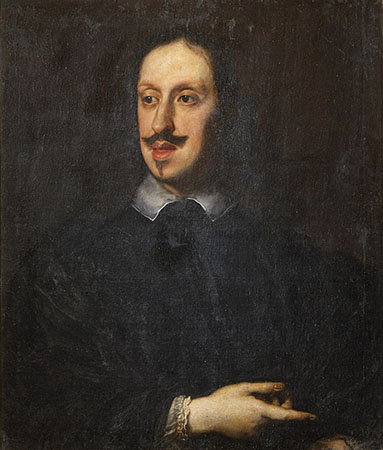
15 November 1629: “…Sig. Prince Francesco is going forward with his treatment with the greatest happiness, and this evenign we were in Apolline [?] in his chamber to hear the music and the arias sung by Domenichino, partly to the chitarrone, played by himself, and partly to the harpsichord, played [touched] by Frescobaldi, and without our being aware of it, the three hours flew away.”
9.41 Mediceo f. 5392. Lettera di Giovan Carlo a Matthias de’ Medici (1613-1667, letters dated 1628-59), documento 12, S. 16f., Firenze, 15.10.1629: (S. 17) “… Il signor Principe Francesco sta seguitando auanti nella sua cura con grandissima felicità, e questa sera siamo stati in Apolline [?] nella sua camera a udir le musiche e l’arie cantata da Domenichino, parte sul chitarrone, sonato da lui medesimo, e parte sul grauicembalo, toccato dal Frescobaldi e senza che ce ne stiamo accorti, sono uolate le tre ore” (Mamone 2003).
[23 November 1629, during a season of bad weather] : “and we make sure to maintain ourselves happily in every manner than we can, therefore in the evening I often have Frescobaldi with me before supper, and after [supper] the Signori, Leopoldo and I, sing to the harpsichord many octaves of the Secchia [Rapita] in honor of the count of Culagna”
9.42 Filza 5392: documento 50 Firenze 23.11 [1629] [“Maltempo”]: “e procuriamo di guardarci più che si può in ogni modo allegramente, però la sera ho spesso da me il Frescobaldi innanzi cena e dopo li Signori Leopoldo et io cantiamo su l’instrumento molte ottave della Secchia a onor del Conte del Culagna”
9.43 The Count of Culagna (“Count Sadass”), a penniless braggart, is the best-known character in La secchia rapita, the great heroico-comic epic in ottava stanzas (abababcc) by Alessandro Tassoni (1565-1635), first published under Tassoni’s name in 1624. It is certainly a suprise to see the organist of the Cappella Giulia accompanying on the harpsichord the bumptious Giovan Carlo and his twelve-year-old brother Leopoldo as they improvise Tassoni’s robust stanzas to an aria da cantar ottave (one possibility of which was the Ruggiero).
9.44 After the Corsini celebrations in 1629, Frescobaldi was again associated with Marco da Gagliano in 1630 for the consecration of the new cathedral of Colle Val d’Elsa by its bishop, Cosimo della Gherardesca. The church was designed by Fausto Rughesi of Montepulciano, architect of the façade of the Chiesa Nuova in Rome. Although the foundation stone of the cathedral had been laid in 1603 by bishop Usimbardo Usimbardi, construction only began to move with the intervention of the archduchess Maria Maddalena. Even so, a drawing dated after 1635 shows that the usable part of church was still limited to the choir, the transept, and the first bay of the nave. The “completed church, which is used for services” (“chiesa perfetta, che s’offitia”), was divided “from the incomplete one” (“dall’imperfetta”) by a wall with a gate in it (fig. 9.11: Romby 1992, 75).
Figure 9.11 a
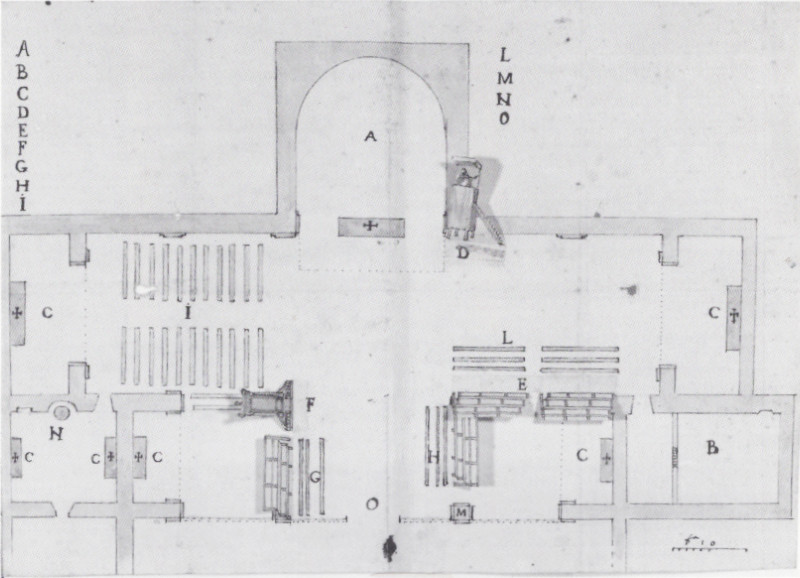
Figure 911 b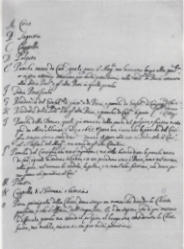
9.45 The cathedral possessed a relic of the Holy Nail, which was venerated by the Medici, with its own altar, and bishop della Gherardesca often brought Florentine musicians for special occasions. The new church was endowed with two organs in cantorie facing down the nave in the transept walls on either side of the high altar, one instrument with metal pipes, the other with wooden ones (Colle 1992, 82). The organs seem to have been placed originally on platforms. For an office of the dead on 26 October 1622 della Gherardesca began to use “the wood organ on the highest platform made for the purpose, which suits most excellently” (“l’organo di legno in summo palcho fatto apposta che sta eccellentissimamente”: Salerni 1986, 49-50). The cantorie were installed on 26 August of 1626 by Lorenzo Usimbardi, brother of bishop Usimbardo Usimbardi.[33]
9.46 On the consecration of the church bishop della Gherardesca recalled:
I had invited and there came six musicians of the finest in Tuscany, the signori Marco da Gagliano, Maestro di Cappella of the Grand Duke, the organist Gerolamo Frescobaldi, Domenico Sarti [soprano], Piero Raffaelli [bass], Michele Magnani, and Agnolo Conti [theorbo]; Maestro Giovanni Battista da Gagliano [theorbo] could not come, although I had also invited him. The most excellent wood organ was given as per the Instrument Notarized this day by Gio: Banchini [notary]. It was all well represented in two inscriptions on the two marble partitions [particelle] which rise above the Organs made by me.[34]
9.47 In the contract for the donation of the organ, signed the same day, 30 June 1630, Frescobaldi is described as “unique and most singular in Europe in playing organs” (“in organorum modulamine in Europa unico et singularissimo”). Of Frescobaldi’s participating colleagues not previously mentioned, Piero di Raffaello Raffaelli was a bass who entered the court service in 1613 (paid sc. 10 a month in 1631); he sang at the Duomo at least from 1622 to 1636 (Kirkendale 1993, 350. Michele Magnani does not seem to appear in Florentine court documentation.
9.48 The consecration ceremonies in Colle Val d’Elsa began on 30 June with first vespers, followed on 1 July (S. Martial) with terce and a pontifical mass by Marco da Gagliano sung “with most beautiful Music since from Florence there will appear Sig. Marco da Gagliano Maestro di Cappella of the Most Serene Grand Duke with five other of the principal singers and players” (“con bellissima Musica già che di Firenze comparirà il Sig. Marco da Gagliano M.ro di Cappella del Ser.mo Gran Duca con cinque altri musici e sonatori principalissimi.”) A “Devout Motet” (“Devoto Mottetto”) was sung at the Elevation, then a “Mottetto allegro” in the organ loft (“in su l’organo”) to prepare for the masses consecrating the individual altars of the cathedral. Pontifical vespers followed in the late afternoon, and compline in falsobordone ended the celebration.
9.49 In 1630 Frescobaldi also took on a secondary responsibility, according to the archive of the guild of the Calimala, a guild of importers, finishers, and sellers of Transalpine cloth, which administered the “Temple and Oratorio of San Giovanni” (the Baptistery):
15 October 1630 … hear how that for the death of Pierantonio di Pagolo Parigi the place of organist of the oratorio of San Giovanni was vacated … they elected and deputed the said M. Girolamo Frescobaldi for [a year] as organist of San Giovanni in place of Parigi.[35]
9.50 This must have been a rewarding job. On 31 March 1592 Emilio de’ Cavalieri had written to Marcello Accolti:
… you will know that the choirs for music in San Giovanni are so commodious, and the organ of the church is so good, that no [further] expense or effort is necessary, so that in one day one can make there the best music that can be made with the musicians of Florence.[36]
9.51 One further musical service of Frescobaldi has come to light. The diarist Tinghi records that during Holy week “On 23 March 1632 [Florentine style: Wednesday of Holy Week of 1633] His Highness heard matins at home that is in the church of San Niccola [Pisa], having brought from Florence his musica, and it was the composition of S.r Frescobaldi.[37]” A corridor where musicians were placed connected the Palazzo Ducale with San Nicola, where a choir gallery in the south transept accommodated the three- and four-choir ensembles especially characteristic of Holy Wednesday in Pisa.
9.52 In the pre-Vatican II Roman rite matins and lauds of the triduum sacrum (Maundy Thursday, Good Friday, Holy Saturday) were anticipated the previous evening and known as Tenebræ. In 1633 Easter fell on 27 March. On 24 March matins of Maundy Thursday by the theorbist Angelo Conti were performed, and on 25 March Good Friday matins by Giovanni Battista da Gagliano were sung. A Roman manuscript now in the Museo Internazionale e Biblioteca della Musica of Bologna contains a setting from the Lamentations of Jeremiah, “Jod: manum suum misit hostis” (the opening of the third lesson for Matins of Maundy Thursday, feria V. in Coena Domini lectio iii) attributed to Frescobaldi (see Catalogue III.B.6).
9.53 Francesco Nigetti’s interest in Frescobaldi, whetted by the two volumes sent to him by his brother-in-law Toscani, led Nigetti to study with Girolamo soon after the latter’s arrival in Florence. The twenty-one-year-old Nigetti had previously studied organ and composition with Marco da Gagliano. He spent 1629 working with Frescobaldi at the organs of the ducal churches of Santa Felicità and San Lorenzo, a training that resulted in his appointment on 11 December 1629 as organist and maestro di cappella of the pieve (parish, now cathedral) of Santo Stefano in Prato in succession to Lorenzo Brunelli. As of 14 January 1630 Nigetti had not taken up the post, and he may not have had any subsequent appointment. In 1649 during his (successful) candidacy to succeed another Frescobaldi pupil, Valerio Spada, at the organ of Santa Maria del Fiore, the members of the Opera del Duomo wrote the Grand Duke that “[Nigetti’s] great talent is as if buried, since he has never had an employment or benefit in matters of music.[38]”
9.54 Despite the insistence of the Florentine musical theorist Giovanni Battista Doni that Frescobaldi was ignorant of the subtleties of ancient musical theory, Nigetti’s later invention of an omnicordo may derive in part from the lore of Vicentino’s archicembalo transmitted from Luzzaschi through Frescobaldi. The instrument on which Girolamo played at the Roman palace of Cardinal Alessandro d’Este in 1619 clearly was no ordinary harpsichord, since Frescobaldi was the only musician in Rome who could play it, and that only “con gran studio.” The organ of Cardinal Borghese that he played “very harmoniously” also seems to have had an unusual temperament. Such instruments were also prominent at the Florentine court (see Chapter 11 and Montanari 2008).
9.55 Girolamo’s influence was extended to a second generation of Florentine musicians through Nigetti, who had his own pupil Giovanni Maria Casini (1652-1719) memorize all of Frescobaldi’s music in the course of Casini’s studies with him in 1674-80. Girolamo’s teaching was perpetuated in Tuscany by a number of other pupils as well. Bernardo Roncagli (ca. 1614-92) served the Signoria of Lucca as maestro di cappella, Filippo Bandini became organist in several churches of Florence, and the Pistoiese Valerio Spada (who was sent from Pistoia to Rome in 1638 by Bartolomeo Rospigliosi to study with Frescobaldi) was first organist of the Duomo in Florence from 1645 until his death in 1649.[39]
9.56 About 1659, when Don Severo Bonini was writing up his Discorsi e regole, he noted that there was still active a talented Roman woman, Lucia Coppi (1625-99), who had studied with Frescobaldi, although obviously not during his Florentine sojourn (see Chapter 10). She was on the Tuscan court ruoli 1664-69 at a salary of sc. 8[40]. Lucia formed part of the Luzzaschi-Frescobaldi-Nigetti succession: on her marriage in 1664 the Marchese Niccolini gave her a collection of music and a number of instruments including “Another [keyboard] Instrument with five rows of keys to pass imperceptibly through all the Tones the invention of Nigetti made by the son of Maestro Vincenzio [Stefano Bolcioni].”[41]
9.57 In January 1640 the Florentine mathematician and musician Alberto del Vivaio had written to Nigetti:
By the bearer of the present [letter] I send for the first book of Toccatas of Frescobaldi in the first printing of which I spoke yesterday morning to Your Lordship, and if you are pleased to oblige me you may consign it to the aforesaid, and in a few days I will return it to Your Lordship. I am curious to see it and you will pardon me the inconvenience…[42]
9.58 In 1652 Scipione Giovanni, organist and maestro di cappella of the Florentine Mont’Oliveto, dedicated to the Duke of Modena the Partitura di cembalo, et organo (Venice, Vincenti), a collection of keyboard works published at the insistence of del Vivaio. In his preface Don Scipione recalled that Frescobaldi had furnished del Vivaio with manuscript works for training children in music and sight-reading:
I shall not fail to say, that the Aforesaid Sig. Alberto de Vivaio delighting to instruct for his amusement certain young children, with the practice of tablature, he presents them wonderfully to the World, many of them playing whatsoever Sonata no matter how difficult at sight, whence I am pleased as did Sig. Girolamo Frescobaldi of happy memory, to serve this gentleman with my manuscript works.[43]
9.59 Don Scipione himself repeated Frescobaldi’s performance instructions from the second version of Toccate I almost verbatim at the end of the preface to his first book of Intavolatura of 1650 (Perugia, Bartoli: Sartori 1952, 1650d).
9.60 Frescobaldi’s documented activity in Florence occurred before late 1630 and the advent of the plague, the male contagioso. Apparently brought to Italy through the sack of Mantua by German mercenaries, by June it had advanced as far down the peninsula as Bologna, and by early August 1630 the Florentine health authorities were investigating the need for clean straw mattresses for the poor as a precautionary measure. Cities such as Florence and Lucca were cut off from the outside world by quarantine. The conditions of the disease were horrific. A Bolognese doctor reported to the Health Magistracy in Florence:
In some people very painful buboes appeared in the groin, and they showed in their center a tuberculum like a vetch seed. Some of the patients experienced anxiety, headache, thirst, small red spots that looked like flea bites on the skin, vomiting, and cloudy urine … Besides those mentioned, the usual symptoms were delirium, dry tongue, and carbuncles in various parts of the body other than the gland areas … death ordinarily occurred by the seventh day, and for some it occurred by the fourth.[44]
9.61 Paradoxically, the plague gave a boost to religion, since those who were not ill themselves or tending the sick flocked to the churches (where they probably spread the infection). The Grand Duke distributed 150,000 scudi in 1631 alone and made his daily round of the city on foot, since he had allowed his horses and carriages to be requisitioned. The economic life of Florence came to a complete halt for six months in 1631 and again for four months in 1633. The total of plague victims has been estimated at 9,000 out of a population of 76,000, or over eight per cent of the inhabitants.[45]
9.62 When the disease broke out again in the spring of 1633, as a last resort on 21 May a miraculous image of the Madonna was carried from Impruneta into Florence, through San Frediano, across the Ponte Santa Trinità to the duomo, and out by the Costa San Giorgio: “and from her Coming the illness began to subside” (“e dalla sua Venuta il male cominciò à cedere”).[46] Within six weeks the hospitals were empty, and the Grand Duke could set about trying to rebuild the Tuscan economy. (The altar of the relic in Impruneta is now covered with a silver frontal, on which Ferdinando’s son the pious Cosimo III is seen kneeling before the miraculous Madonna.)
9.63 During these same years Florence was subjected to another form of attack as well: the trial of its most distinguished citizen, Galileo Galilei, by the Inquisition for illicit doctrines such as heliocentrism expounded in the Dialogue on the Two Great World Systems. This was published in Florence in February of 1632 by Giovanni Battista Landini, who had published Frescobaldi’s two volumes of Arie musicali two years earlier. In one interpretation, the prosecution of Galileo was pressed because Urban VIII, previously an admirer of the great scientist, believed that Galileo had caricatured him as Simplicio in the Dialogue. It has also been suggested, however, that a show trial was concocted by the pope and his nephew Cardinal Francesco Barberini to pre-empt a possible prosecution for heresy, a capital crime. Galileo was summoned to Rome late in 1632 and tried in April of 1633 by a commission that included Cardinal Francesco Barberini with Galileo’s former student and Frescobaldi’s first patron, Cardinal Guido Bentivoglio, as Supreme Inquisitor General—neither of them unsympathetic to the great scientist. On 22 June 1633 the seventy-year-old Galileo, clad in the white habit of a penitent, knelt in the hall of the Dominican church of Santa Maria sopra Minerva and abjured his errors and heresies, a ceremony repeated in Florence in the refectory of Santa Croce on 12 July 1633.[47]
9.64 The imprimatur of the first volume Frescobaldi’s two collections of secular songs is dated 25, 27 September 1630; the imprimatur of the second 25, 29 September. The signers are Piero Niccolini, Vicario [later archbishop] of Florence, Frate Clemente Egidi, Inquisitor General of Florence, and Niccolò dell’Antella, “Auditore della Giurisdizione” and “Auditore dell’Ordine dei Cavalieri di Santo Stefano.”
9.65 Frescobaldi dedicated the first volume to its patron, the Grand Duke (the presentation copy still exists in the Biblioteca Nazionale in Florence): “And Your Serene Highness having contributed to the production of the Volume only to please the Author” (“Et auendo l’A. V. S. concorso alla produzione del Volume solo con gradirne l’Autore”) (fig. 9.12 Arie musicali). The second volume is dedicated to the condottiere and art-collector Roberto Obizzi (d. 1647), the Grand Duke’s Master of the Horse (Traina 2002, 272-82): “Marchese of Orciano, [illegitimate] son of the illustrious Pio Enea Obizzi, noble of Padua, Ferrara, and Florence, condottiere of men of arms and collateral general of the Most Serene Republic of Venice.”[48] The dedication was perhaps in compliment to Obizzi’s elevation to the marquisate of Orciano on 19 April of 1630.
Figure 9.12
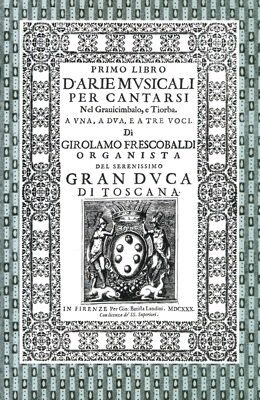
9.66 Obizzi was a Paduan noble from a distinguished and intellectual Ferrarese family owning lands in Tuscany and in the Modenese (he had followed Cesare d’Este to Modena in 1598) and a palace in Ferrara. In 1629 he had received a papal pardon for the murder of a luogotenente civile that had resulted in his banishment from Ferrara in February of 1598. Obizzi was a passionate art-collector and maintained a court painter and musicians; in 1631 he commissioned paintings of San Domenico and the newly-canonized Florentine Sant’Andrea Corsini from Guercino. Obizzi resigned from the Florentine court the year after the publication of the Arie. He conveyed his decision in a letter of July 1631 to Enzo Bentivoglio, a fellow amateur of theater and chivalry, with whom Frescobaldi had been in contact through Enzo’s brother Guido as recently as the end of October 1627:
9.67 Roberto Obizzi in Florence to Enzo Bentivoglio in Ferrara, 18 July 1631:
Sig.r marchese mio padrone, io mi son licenziato da questi ser[enissi]mi p[ad]roni perché non posso più far la fatica, havendo io 40 anni più del padrone, e perciò mi vogio ritirare a Ferrara a casa mia per vivere in quiete questo poco ch mi resta (Fabbri 1986, 237, n. 11).
Sig. Marchese my patron, I have resigned from my employment with these Most Serene masters because I am no longer up to the job [literally, can no longer make the effort], since I am forty years older than my master, and therefore I want to return to Ferrara to my own home to live out in peace that little bit of time that remains to me.
9.68 In 1634 Obizzi was again living in his Ferrarese palace on Via Saraceno, “in the contrada called the New Poultry-yard under the parish of San Gregorio” (“posto nella contrà detta della Beccaria Nuova sotto la parrochia di San Gregorio”), and in 1635 he was elected Giudice de’ Savi.[49] Like Enzo Bentivoglio, Obizzi was an amateur of theater and chivalry, and he passed these interests on to his son Pio Enea II, a librettist and inventor of theatrical spectacles.
9.69 In his dedicatory letter of the Arie Frescobaldi alluded once again—for the last time—to his own Ferrarese birth and training with Luzzaschi. The contents of the two books of Arie musicali, however, show that Frescobaldi had traveled far from the musical tradition of Ferrara. The collection contains strophic arias and through-composed madrigals (a Florentine tradition), but its most striking feature is the inclusion of eleven works in stile recitativo, a style which Frescobaldi had avoided previously in his published vocal pieces. The importance of these settings is further emphasized by their placement at the head of each book. This is all the more surprising because pure recitative was beginning to lose its popularity even in the city of its birth: in 1635 the Florentine Giovanni Battista Doni advised against setting sonnets in recitative style.[50] The Arie was in fact the only collection containing monodies to be published in Florence between 1619 and 1635. When Florentine composers took up the medium again they cultivated a lighter and less declamatory style.[51] The inclusion of settings on the Romanesca and the Ruggiero seems to echo a Roman vogue of about 1615, also followed by Monteverdi in the Romanesca variations in his seventh madrigal book of 1619. Frescobaldi’s Arie also contains settings of more recent basses, the Passacagli and Ciaccona. The presence among the texts in the Arie of a lettera amorosa and a partenza amorosa (both texts set previously by Giovanni Valentini in his Musiche à due of 1622) also points to the influence of similar settings in Monteverdi’s seventh book of 1619.
9.70 The attempt to discern other possible stylistic influences through concordances is unrewarding. Frescobaldi does not seem to have relied on the usual Florentine authors of poesia per musica. Only eight texts from the Arie are so far identified: two by Della Casa (1590), one by Desiderio Cavalcabò, one by Marino, two by Girolamo Preti (1614), and two by Francesco Balducci (1630), better known as the author of two oratorio libretti, a version of one of which was set by Carissimi.
9.71 If we are to believe Giovanni Battista Doni, Girolamo’s literary culture was so sketchy that “when some aria is sung in his house, as soon as he runs into some word a bit uncommon, he immediately needs to consult his wife.”[52] On the other hand, in the third impression of his Mormorio d’Elicona (Venice: Sarzana, 1630), the poet Giovanni Andrea Rovetti noted, “Ecco l’alba rugiadosa (‘See the dewy dawn’). It describes a happy day, in which he saw his Lady restored to health. Set to Music by Sign. Girolamo Frescobaldi, as he has done for many other Compositions of the [present] Author, being most perfect in the Profession, as the world knows” (“Ecco l’alba rugiadosa. Descrive un lieto giorno, nel quele vide la s[ua] D[onna] risanata. Messo in Musica dal Sign. Girolamo Frescobaldi, sì come ha fatto di molt’altre Compositioni dell’Autore, essendo perfettissimo nella Professione, come il monda sa.”) At least one text in the Arie,” “Degnati o gran Fernando,” as well as the dedicatory sonnet, “Signor, c’ora fra gl’ostri,” must have been written to order, and they perhaps represent early efforts of Domenico Frescobaldi, whose volume of Latin poetry and epigrams dedicated to Urban VIII was written 1632-34.[53]
9.72 Another possible source of influence on the Arie has been pointed out by John Walter Hill (Hill 1987), who examined Frescobaldi’s contacts with the musical circle of Cardinal Montalto in 1615. In particular, he noted the sonnet settings of a Florentine composer, Rafaello Rontani, who had moved to Rome in 1616. These were published in 1619 but are also found in one of the surviving monody manuscripts which preserve music from the circle of Montalto. (Montalto was a crony of Cardinal Del Monte, who served as an agent of the Grand Duke of Tuscany in Rome.)
9.73 In the general context of Frescobaldi’s work, the Arie, his one Florentine production, seems an anomaly occasioned by the predominance of vocal music at the Tuscan court and a lingering local tradition of stile recitativo. And yet this same insistence on affective declamation is fundamental to Frescobaldi’s art as a keyboard composer, although there it is balanced by his remarkable contrapuntal sense. The classic expression of this fusion is Girolamo’s Fiori musicali, the collection of three organ masses and related works published the year after the composer’s return from Florence. Is is tempting to regard this volume of instrumental, contrapuntal, and for the most part liturgical music as the counterpoise—or even the reaction—to Frescobaldi’s Florentine experience as embodied in the Arie.
9.74 By 1634 Florence had little more to offer Frescobaldi. Its intellectual achievement had been humiliated in the person of Galileo, its population was decimated, and the Grand Duke’s resources for patronage were momentarily exhausted by the virtual bankruptcy of the state. More important, Frescobaldi had been offered the ultimate prize of a Roman artist: the reigning papal family had summoned him back to the City to enter their service.[54]

